The Abbey of St. Walburga is a silent, solemn place. The absolute quiet of it reaches around and squeezes until you relent and rest. It’s cold there in October. Colder during the mornings when snow falls so carefully it barely exists.
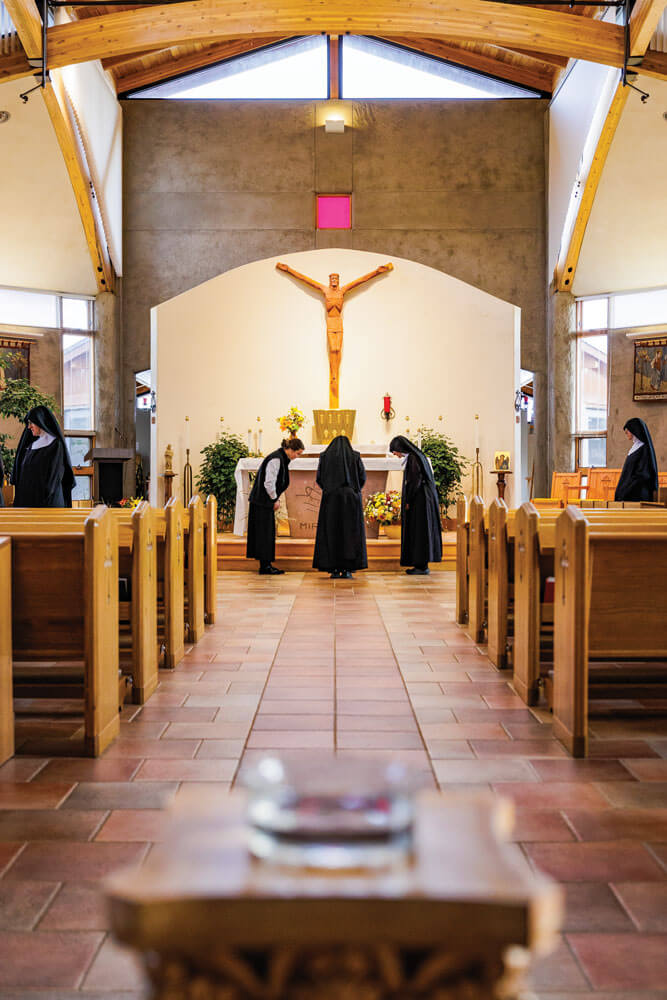
As contemplative nuns, the sisters’ primary duty for the Church is to pray the full Divine Office. Here they gather at 5 p.m. in the sanctuary for vespers, one of seven prayer services they hold every day.
Maybe it’s the altitude. Maybe it’s sitting in the palm of beefy boulders stacked one upon another, each bulky mass appearing as if, with a little fairy dust, it could animate. Or maybe it’s the seriousness of the work, of a life dedicated to consistent prayer. Whatever the one or many reasons, the abbey is a place of deep reflection, bottomless contemplation, and unfaltering respect.
It is all of that.
It just isn’t only all of that.
When you drive into a monastic abbey at the base of the Rocky Mountains, in an area of deep solitude, just south of the Wyoming border, located on the edge of Colorado’s Front Range in Virginia Dale, where civilization is mostly a suggestion and not a confirmation, you don’t expect the first impression to be one of whimsy. You don’t expect to laugh or to break that silence.
But you will.
On the front gate, as cows graze idly on a distant hill in the background, a sign greets all who come to visit, to pray and to live, “NOTICE: This is God’s country please don’t drive through it like hell.”
You also don’t expect to find a ranch dedicated to soil health principles.
But you will.
If you don’t think a monastic abbey of the Order of St. Benedict, with a strict prayer schedule, a lifestyle of moderation and hours of observed silence, will be a place of successful beef production but also unending enchantment, you’re going to be surprised.
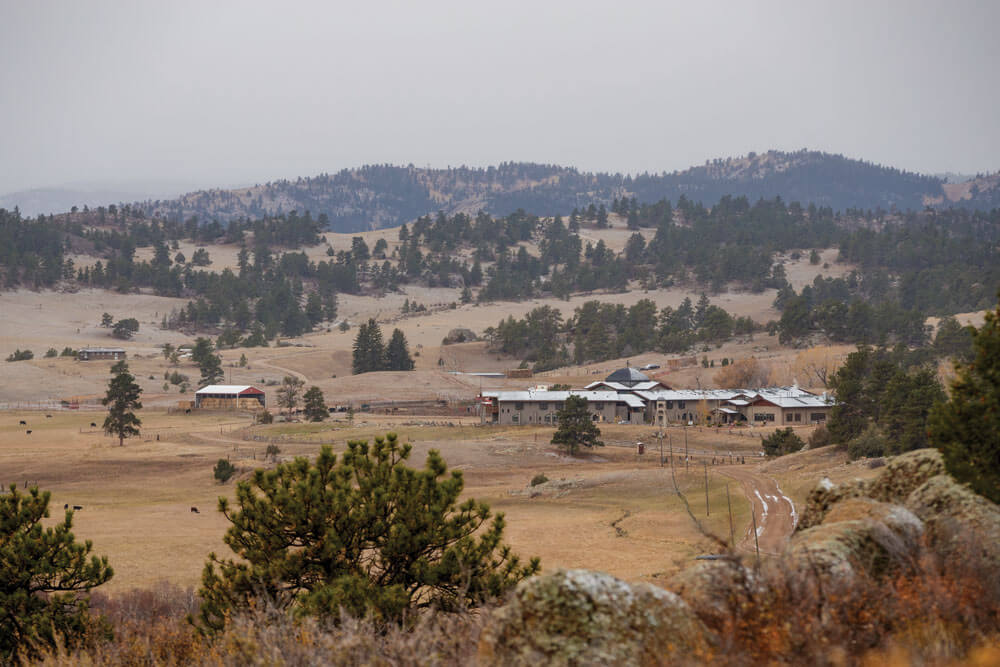
First Impressions Don’t Last
Sister Maria-Gertrude Read walked through the abbey lobby in cargo pants, a hoodie and a bucket hat over her long, white, flowing veil, which she tosses over her shoulder like Rapunzel’s golden locks when milking their water buffalo, Louisa May.
She wasn’t in her customary black habit, which the sisters refer to as “the blacks,” nor the blue “work habit” made of lighter material. That’s because she was headed to the abbey’s farm, 160 acres of rocky earth with grass that comes but often goes, all dependent on the management decisions made and the rainfall given.
The habit wouldn’t be appropriate clothing for the work ahead. Skirts get caught on fences and in tractor wheels, munched on by animals and snared on branches. These sisters are reverent but also practical. Here, you must be both.
“We don’t do dangerous things in flappy clothes. That’s why we wear jeans and stuff on the farm, so we don’t end up in a dangerous situation,” explains Sister Gertrude in her distinctly Colorado accent that’s easy to recognize and impossible to emulate.
Their daily clothing is chosen based on the work ahead, while also always being a sign of their complete devotion to God.
“Our black is our formal wear. We always wear it, definitely in prayers, but also anytime we’re doing anything in public, like working the gift shop or going into town. For some of our work, we wear other things that are more practical and protective, but we always wear the veil and the hauben,” she says, using the German word for “wimple,” the headdress covering her head, neck and side of face. “We do get quite the farmer nun tan.”
What you see of Sister Gertrude’s face is undeniably sweet and, yes, a little tan. However she dresses, she has that approachable, realness quality that makes you want to be around her and smile for no reason when you are. She’s tall. Thin. Delicately boned. Nothing about her shoulders look sturdy enough to carry the weight of being the farm manager for the abbey, but she is. And has been for four years, all of them dedicated to working with the natural habitat to create healthier soil and healthier cattle.
The farm is directly behind the abbey on the next higher hill, which is overlooked by the next higher hill, which is overlooked by the next until you reach the clouds. All of it is used for the roaming Galloway cows, who dot the landscape with their Oreo-colored wooly coat and Mickey Mouse ears. Mixed among them are a few sturdy Angus here and there.
You could walk from the abbey to the farm, but it’s best to drive. If the cold doesn’t get you, the altitude might.
Now loaded in two vehicles with three nuns dressed in pants and knit caps over their veils and hauben, we’re on our way. We pass a posted sign that says, “Speed Limit 14 1/2.” Yes, it’s a joke. One of many nailed to fences, on doors or hanging from a wall on the farm to designate the “party cow” area or issue a warning to “beware of attack cattle.”
The abbey farm is a place of labor, like all farms are, and also a place of joy. It’s a tough combination to pull off, but the sisters do. With 40 head of cattle, all grazing contentedly around God’s great landscape, this ranch feels a little closer to heaven than other parts of the world. And, with the ranch ranging from 6,775 feet to 7,133 feet in elevation, it is.
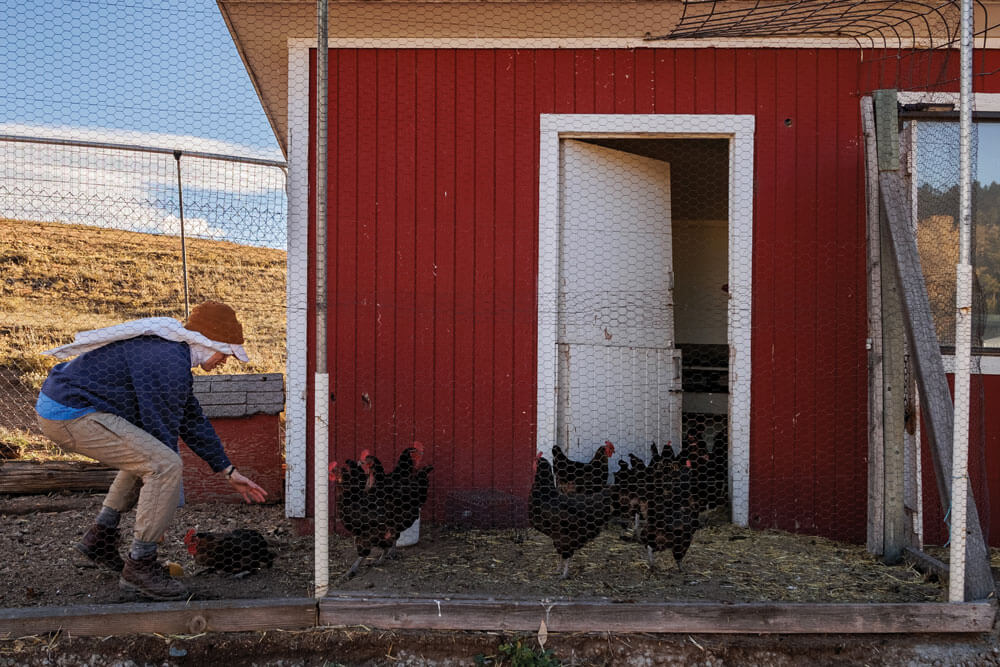
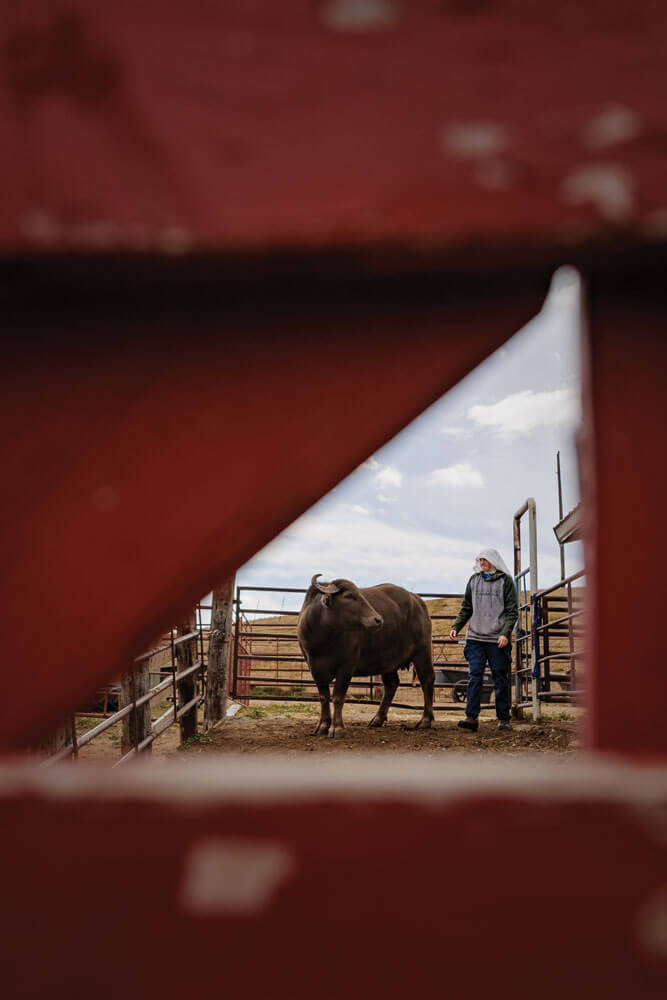
Left: Sister Maria-Placida Hamilton tends the abbey’s hens. Right: Sister Gertrude guides Louisa May the water buffalo back to her small corral after milking her. The nuns make cheese from her milk.
An All-Woman Regen Ranch
Sister Maria-Walburga Schortemeyer didn’t let her wrist brace slow her down. When the bulls needed to be separated, she separated them.
It was day two on the abbey farm, and Robert Kleinhans, a local farmer, was helping move the abbey’s bulls to a winter pasture in Cheyenne, Wyoming. Once loaded inside the trailer, however, the boys started to tussle. Roughly 4,000 pounds of fighting bull were having a loud conversation head-to-head. While they argued over who would dominate, the trailer bounced side to side, threatening the truck hitch. Time to separate them.
Sister Walburga, who studied literature in college and had zero farm experience when she joined the abbey at age 22, walked into that sardine can stuffed with literal butting heads, separated the bulls and closed the metal partitions. No more bouncing trailer.
She’s dealt with a few frustrated animals in her time. Now 54, she spent 19 years as the farm manager and trained Sister Gertrude, not only in basic farming, but also in regenerative principles. When she walked out of the trailer, the two shared a brief, knowing glance. And that was that between teacher and protege.
One of the gifts of farming, but challenges of farming, is that things are going to go wrong, and you have to roll with those, recover from those and accept mixed results. It’s not a failure, it’s a learning experience.
Sister Gertrude
“In Germany, in one of our sister houses there, all the sisters have to go to school. To be a cook, you have to get your master’s in cooking. To become a farmer, you have to get your master’s in agriculture. I’m sure that could be useful, but I love how we’ve passed things down, like regenerative (principles), from sister to sister,” says Sister Walburga, who started using regenerative practices at the farm during her management years. “We learn from volunteers in town who come and are so kind to share information and help us out. People are so awesome.”
Seeking ways to work with their unique location in the mountains, their unique manpower of all women and their un-unique need to cut costs, Sister Walburga began studying and implementing regenerative principles. Now, the farm has found harmony with its environment and work force.
The sisters interseed hay pastures with alfalfa, use bio controls to manage weeds, take a measured approach to any usage of antibiotics, rely less on chemical inputs, work with flood irrigation to maximize water usage, implement rotational grazing and breed mostly Galloway cattle for their smaller frame and thicker coat, which makes them perfect for mountain grazing.
“The challenging thing about regenerative is knowing when to do things,” says Sister Gertrude, such as determining the timing for treatments, seeding and even butchering.
Annually, the abbey harvests about 35 steers and heifers and has 75 to 100 customers who purchase their grass-fed beef directly from the abbey. This is the size and scope that works best with the time they have to work and what the land can naturally support. In farming, that’s a sweet spot.
“One of the goals is to match your farming methods with the land so you don’t have more than you can sustain,” says Mother Maria-Michael Newe, who managed the ranch from 1985 to 2003. “The world is always ‘have more, have more, have more.’ That’s not true. There’s a sense where you have to have what it can sustain and sustain it well. I think we’re just figuring that part out right now. What is a good amount of cattle, and the mowing of the hay, and everything that our land can sustain in good times and bad?”
Overall, healthy soil principles work in simpatico with the abbey’s purpose to honor God, even in how He designed their ranch’s ecosystem to operate.
“We see creation as something that is not to be exploited. It’s a gift to steward,” Sister Gertrude says, although that doesn’t mean everything always works perfectly. “You have to be willing to face a certain amount of failure. One of the gifts of farming, but challenges of farming, is that things are going to go wrong, and you have to roll with those, recover from those and accept the mixed results. It’s not a failure, it’s a learning experience.”
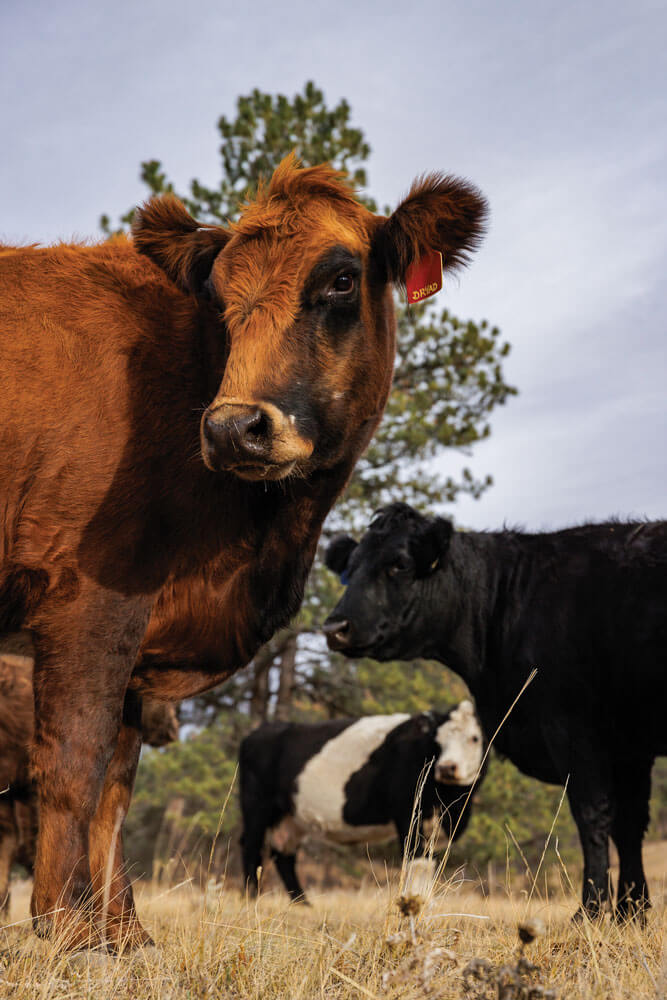
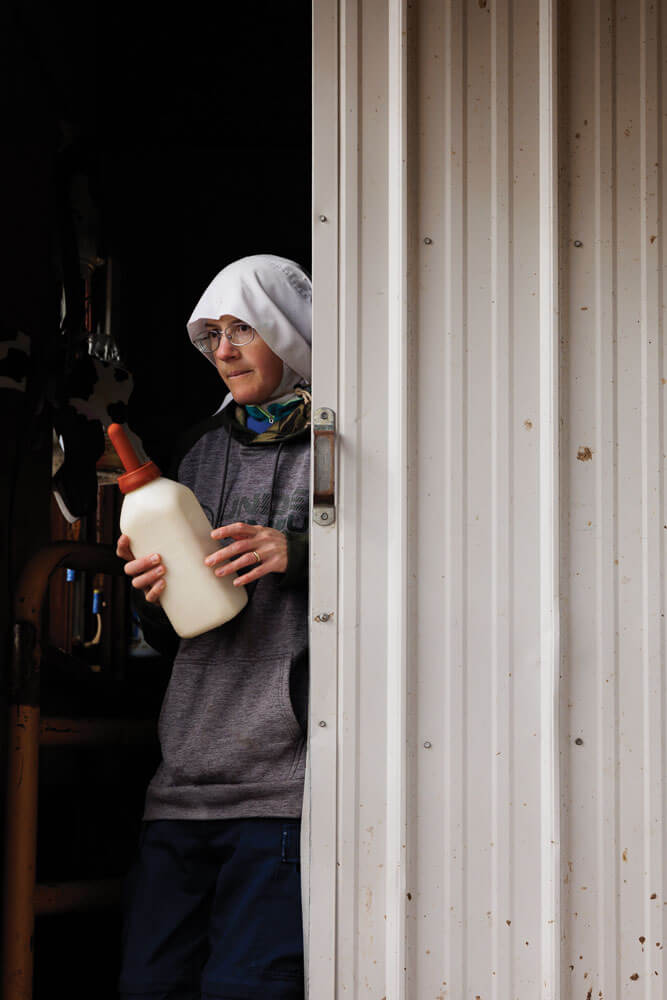
Nuns’ Work Is Never Done
The farm isn’t the only area requiring labor at the abbey. There’s cooking and cleaning, running the gift shop and handling the visiting guest needs, and all other monastic daily duties.
Then there are the hours of prayer, beginning with the 4:50 a.m. vigils and scheduled throughout the day until the 7:30 p.m. compline, all referred to as the Divine Office. Ranch work must take place during the morning work period, which runs from 9-11:45 a.m., and the afternoon work period, which runs from 2:30-5 p.m.
You don’t see nuns dilly-dally for a reason.
“Our (ranch) work tends to be pretty fast-paced, because we have a limited two hours in the morning and two hours in the afternoon,” Sister Gertrude says.
During a morning work period, Sister Maria-Placida Hamilton and Sister Assunta Kunz, two energetic and youthful helpers, chat with Sister Gertrude in the milk barn, a small structure used for storage, for washing and for milking the water buffalo. It isn’t spacious, but it’s clean, orderly, well used, well-loved and the only spot out of the biting wind.
They’ve got roughly two hours to complete their chores, but you wouldn’t know it by their comportment. Work isn’t done in a frenzy, but it is done efficiently. It’s measured and calmly tackled with lots of mooing from the cows and giggles from the nuns.
Even though chatter is kept to a minimum during their work, the nuns say the typical nun stereotype of dourness and constant solemnity isn’t their life. Their home is a joyful, happy place, evident by their easy smiles and a nearly universal lack of stress lines around the eyes.
“We tend to be stereotyped, I think, especially as being old, crotchety ladies,” says Sister Gertude, looking unstereotypical in a green Under Armour hoodie. “One of the things I love about our community is its quirkiness. Its uniqueness. You never know what we’ll think of next … the image of an ATV with the veil flying behind in the wind? That’s the Abbey of St. Walburga right there. Three sisters piled into an ATV with the fencing equipment falling off and the dog running behind.”
It isn’t far from the truth, in fact. Before a local rancher donated a Toyota Tacoma work truck for the nuns, they drove a Honda Civic Hatchback. Sister Gertrude said the vehicle could hold two nuns and three dogs, while feed bags or needed equipment were strapped to the roof or tossed onto the hood. And away they’d go into the high country.
The truck was an answer to prayer.
What you’ll find at the abbey is a devoted group of young and young-at-heart women who are great conversationalists, quick-witted and always eager to share a funny story or laugh at themselves. Periodically, it’s possible for visitors to catch a glimpse of the sisters snow-sledding, ice skating, jogging or, when Sister Placida is in the mood, riding the water buffalo.
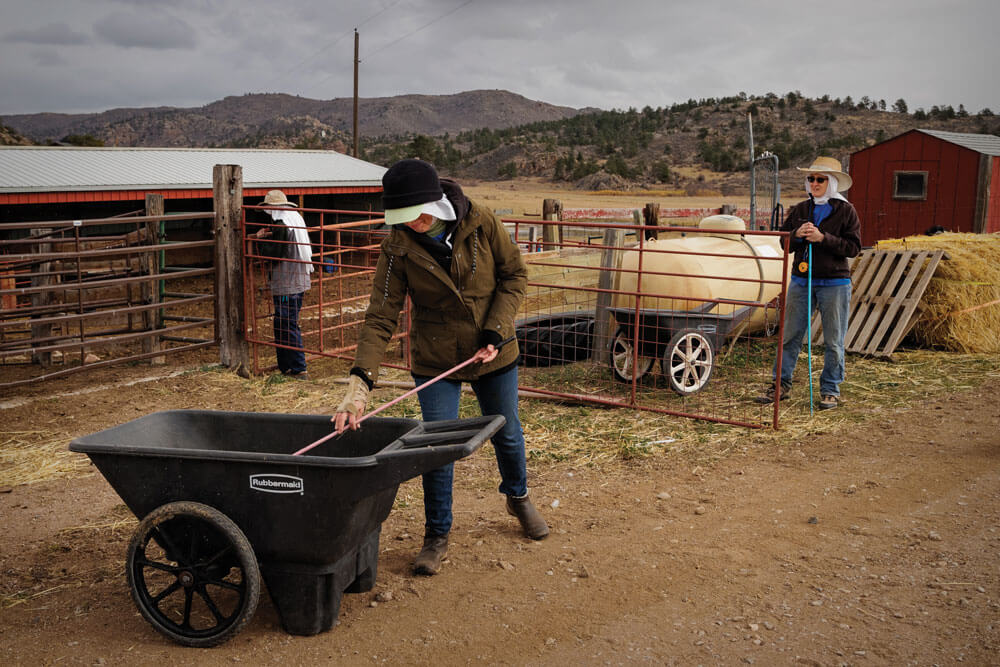
The Hills Are Most Definitely Alive
In the final work hour for the day, Sister Gertude loaded up in the abbey truck and headed to higher ground. The cows were in the hills, climbing among those giant boulders and roaming the thinner air. That means, sometimes, a nun has to go off-roading.
At a particular clearing, she stopped, and we piled out for a glimpse of the world from on top of it. The temperature had dropped significantly already and, before long, the thirst would kickin. In the meantime, we bundle up tighter and gape at the view.
Sister Gertrude takes in the horizon as if she doesn’t see it every day. Then, it’s time to dive deeper into the mountains. Those cows have found a prime spot, but it won’t be easy to reach them. Crammed into the Tacoma, she maneuvers along impossibly tight paths cut between rock and trees. She handles the steering wheel like a pro, pointing out areas of interest and sharing stories of sighting mountain lions.
Finally, we come to rest in a clearing where the hills roll until coming to rest under the hooves of the abbey’s herd.
With a bag of protein cakes, Sister Gertude calls out, “come on!” and interested heads perk up.
The herd only responds to female voices. It’s what they’ve come to know and trust. When local male farmers come to help, they’ve been known to communicate with the herd in falsetto. Otherwise, the cows won’t listen.
Now, a happy collective of rushing wooly bodies and pounding hooves is headed down a slope and back up again to reach the sister for their snack. The sun is softening on the horizon and the farm work for the day is done. It’s time, once again, for her spiritual duties to resume. Sister Gertrude loads up, and we head back. The world needs prayer and, when the rain doesn’t come, so does the farm.
It’s time to talk to God about both.
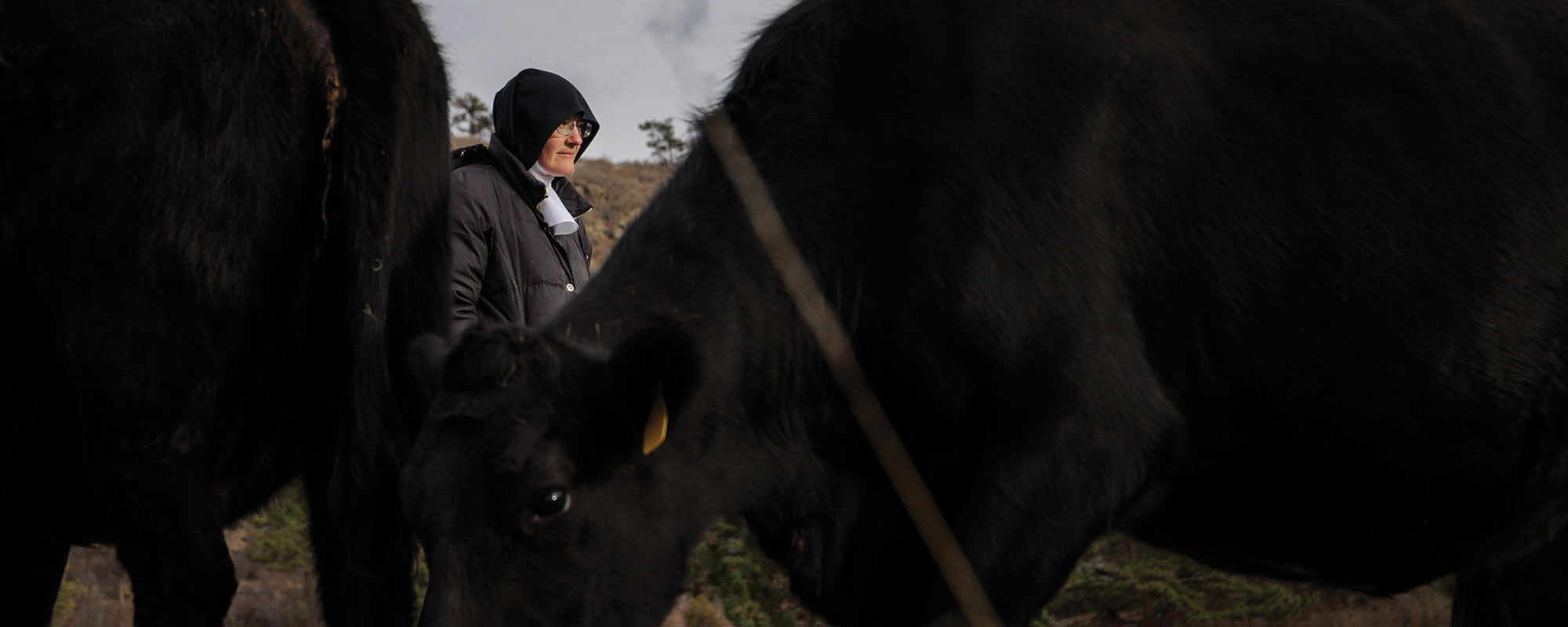
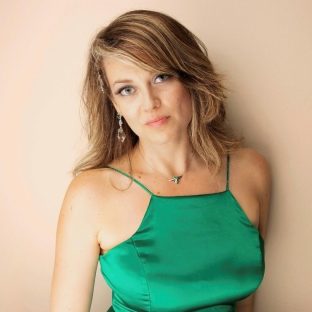
Comments